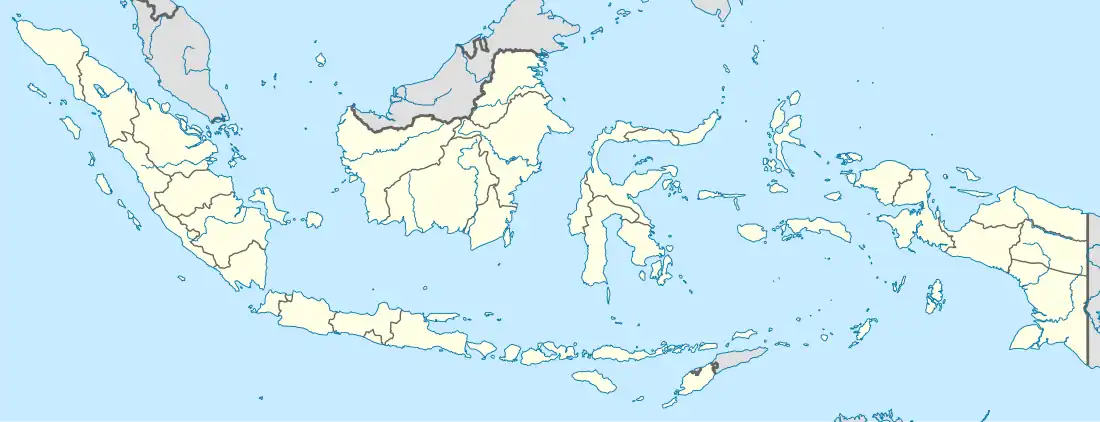Isyaman
Isyaman is an inland village in Mappi Regency, South Papua, Indonesia.
Isyaman | |
|---|---|
 Isyaman Location in Western New Guinea and Indonesia  Isyaman Isyaman (Indonesia) | |
| Coordinates: 7°06′42″S 139°23′46″E | |
| Country | |
| Province | South Papua |
| Regency | Mappi Regency |
| Area | |
| • Total | 2,896 km2 (1,118 sq mi) |
| Population (2018 est.) | |
| • Total | 429[1] |
| • Density | 1,481/km2 (3,840/sq mi) |
| Time zone | UTC+9 (WIB) |
| Climate | Af |
History
At the time of the Dutch arrival, the Mappi region was inhabited by various tribes speaking Trans–New Guinea languages, such as the Awyu, the Yaqay, or the Kayagar.[2] The inhabitant of the area were mostly left alone by the outside world until the first half of the 20th century, when the Dutch started taking an interest in the region. In 1936, a military post known as Mappi Post, was set up on a hill named Tamao at the confluence of the Digoel and Kawarga River near where the village stands today, in order to prevent Headhunting raids which were creating unrest and migrations, and assert Dutch control over the area.[3] Following the Japanese invasion of New Guinea in 1942, and the subsequent low-level bombing of the post by Japanese aircraft, the Dutch fled into the nearby jungle,[4] leaving the post only occupied by a coastwatcher. In June 1944, the Australian Army moved in, installing a radar station which had been previously operating in Bupul, and renamed it Post 5,[5] under the command of an infantry sergeant.[6] The goal was to spot Japanese airplanes coming from the Aru islands or the Vogelkop to attack Merauke. However, as the Japanese airfields were rendered inoperable by allied aerial bombardments, the radar station was removed and the Australian Army departed in January 1945.[7] After the war, Kepi replaced Mappi as the administrative center of the region. The post remained in use as a Dutch military outpost into the 1950s, after which it was abandoned when Western New Guinea was transferred to Indonesia in 1963.
Climate
Isyaman has a tropical rainforest climate (Af) with heavy rainfall year-round.
| Climate data for Isyaman | |||||||||||||
|---|---|---|---|---|---|---|---|---|---|---|---|---|---|
| Month | Jan | Feb | Mar | Apr | May | Jun | Jul | Aug | Sep | Oct | Nov | Dec | Year |
| Average high °C (°F) | 31.4 (88.5) |
31.3 (88.3) |
31.4 (88.5) |
31.2 (88.2) |
30.6 (87.1) |
29.6 (85.3) |
28.8 (83.8) |
29.2 (84.6) |
30.4 (86.7) |
31.4 (88.5) |
32.1 (89.8) |
31.9 (89.4) |
30.8 (87.4) |
| Daily mean °C (°F) | 27.1 (80.8) |
27.1 (80.8) |
27.2 (81.0) |
27.0 (80.6) |
26.6 (79.9) |
25.8 (78.4) |
25.1 (77.2) |
25.1 (77.2) |
25.9 (78.6) |
26.7 (80.1) |
27.4 (81.3) |
27.5 (81.5) |
26.5 (79.8) |
| Average low °C (°F) | 22.9 (73.2) |
22.9 (73.2) |
23.0 (73.4) |
22.9 (73.2) |
22.7 (72.9) |
22.0 (71.6) |
21.5 (70.7) |
21.1 (70.0) |
21.4 (70.5) |
22.0 (71.6) |
22.7 (72.9) |
23.2 (73.8) |
22.4 (72.3) |
| Average rainfall mm (inches) | 303 (11.9) |
281 (11.1) |
332 (13.1) |
280 (11.0) |
241 (9.5) |
146 (5.7) |
143 (5.6) |
112 (4.4) |
125 (4.9) |
162 (6.4) |
225 (8.9) |
278 (10.9) |
2,628 (103.4) |
| Source: Climate-Data.org[8] | |||||||||||||
Notes
- Indonesian statistics. (2019). p.14.
- Gerrit J. van Enk & Lourens de Vries (1997). p.14.
- Boelaars, Jan H. M. C. (1981). pp.4–5.
- Donald F. Thomson. (1953). p.3.
- Simmonds, Ed (2002). pp.26–30
- Dexter (1961). p. 812
- Arnold, Anthony Peter (2013), p. 328.
- "Climate: Isyaman". Climate-Data.org. Retrieved 22 December 2020.
References
- Gerrit J. van Enk; Lourens de Vries (1997). The Korowai of Irian Jaya: Their Language in Its Cultural Context. New York, Oxford: Oxford University Press. ISBN 978-0-1951-0551-3.
- Boelaars, Jan H. M. C. (1981). Head-Hunters About Themselves: An Ethnographic Report from Irian Jaya, Indonesia. B. V.: Springer Science Business Media. ISBN 9-4011-6808-3.
- Boelaars, Jan H. M. C. (1981). "Head-Hunters About Themselves: An Ethnographic Report from Irian Jaya, Indonesia – Notes" (PDF).
- Thomson, Donald F (1953). War-Time Exploration in Dutch New Guinea. The Geographical Journal Vol. 119, No. 1. The Royal Geographical Society (with the Institute of British Geographers).
- Dexter, David (1961). The New Guinea Offensives. Australia in the War of 1939–1945. Series 1 – Army. Volume 6. Canberra: Australian War Memorial. OCLC 2028994.
- Statistics Indonesia. "Distrik Edera Dalam Angka 2019 (Edera Subdistrict in Numbers, 2019)" (in Indonesian).
- Simmonds, Ed (2002). "Radar Returns". World War, 1939-1945 -- Australia -- Radar defense networks.
- Arnold, Anthony Peter (2013). "A Slim Barrier: The Defence of Mainland Australia 1939-1945".